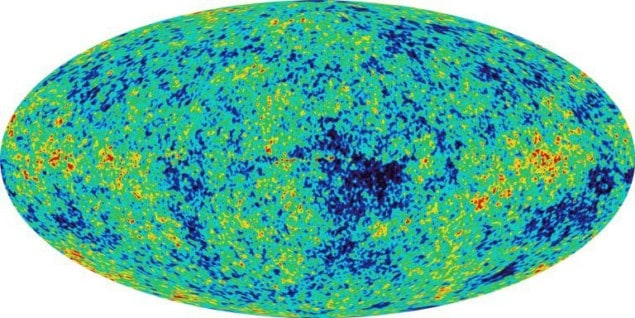
The accelerating expansion of the universe cannot be explained by the Earth residing in a cosmic void. That is the conclusion of physicists in China and the US, who have shown that cosmic microwave background (CMB) radiation has not passed through a “Hubble bubble” before reaching Earth.
In 1997 the physics community was shocked when a study of the motions of distant supernovae suggested that the rate of expansion of the universe is increasing with time – rather than decreasing thanks to the inward tug of gravity. Dark energy is the mysterious substance that many physicists believe is driving this accelerating expansion, but other explanations have also been put forth.
Measurements of this acceleration rely on the Copernican principle – the idea that the universe is the same in all regions and there is nothing unique about Earth’s position in it. The Copernican principle could be violated, however, if the Earth were in a Hubble bubble.
A Hubble bubble is a region that is expanding at a steady but different rate to that of the rest of the universe, which is also expanding steadily. If the Earth were in a Hubble bubble, there would be an apparent acceleration as seen from Earth – and no need to invoke the concept of dark energy.
Scattering from electrons
Now, however, Pengjie Zhang of the Shanghai Astronomical Observatory and Albert Stebbins of Fermilab have analysed the CMB and shown that such a Hubble bubble does not exist. They examined the way in which CMB photons, which were originally created about 400,000 years after the Big Bang, are scattered by free electrons in clouds of gas as the ancient radiation travels from the edges of the universe to Earth.
This scattering causes a change in the temperature of the CMB called the kinetic Sunyaev Zel’dovich effect (kSZ). The kSZ gives a measure of the density and velocity distributions of the electrons encountered by the CMB as it travelled to Earth.
The Copernican principle says that because the velocities of the electrons are random, this will cause the kSZ to cancel out along any line of sight in the universe. However, if the Earth is at the centre of a Hubble bubble, the relative motion of the bubble to the rest of the universe should result in an overall shift of the CMB temperature. Furthermore, the fact that the electrons within the bubble tend to exist in clumps of gas means that the kSZ would also be different in different directions.
The effect was expected to be very small (about one part in 100,000) and only detectable over very small angular scales (about one arc-minute). Such measurements have already been made using both the Atacama Cosmology Telescope and the South Pole Telescope and now Zhang and Stebbins have shown that these contain no evidence for a Hubble bubble.
Null and void
The Hubble bubble is just one of several “void” models that sacrifice the Copernican principle to explain the accelerating expansion of the universe. According to Zhang and Stebbins, any void model that describes the supernovae observations would also be detectable in the kSZ and therefore their work rules out most void models.
As well as backing up the dark-energy explanation, this latest work also tells us something about the nature of this mysterious entity, according to Stebbins. “If dark energy is not uniform as is usually assumed, then one could see this in anisotropies of the CMB in a similar way as in the void models,” he told physicsworld.com.
Ethan Vishniac of McMaster University in Canada, who was not involved in this latest work, described the research as “a very powerful generic argument against the Hubble bubble model; it’s hard to see any loopholes”.
The work is reported in Phys. Rev. Lett. 107 041301.



